Читать книгу Mount Sinai Expert Guides - Группа авторов - Страница 100
Images
ОглавлениеFigure 4.1 Probe types. (A) Linear. (B) Phased array. (C) Large curvilinear.
Figure 4.2 Standard bedside ECHO views. (A) Parasternal long axis, systole; aortic valve open, MV closed. (B) Parasternal short axis, mid‐papillary muscle level. (C) Apical four chamber view. (D) Subxiphoid view.
Figure 4.3 Right ventricular strain. RV size exceeds LV size; RV pressure flattens or bows interventricular septum into LV during diastole (apical four chamber window).
Figure 4.4 IVC transitions into RA to confirm visualization of IVC versus abdominal aorta.
Figure 4.5 M‐mode chest with ‘seashore’ signal. The thicker first horizontal line (arrow) is the pleural line. Above the pleural line are (normal) horizontal lines due to the chest wall. Below the pleural line, where the lung is present, note the ‘sandy’ appearance diagnostic of lung sliding. Lung sliding rules out a complete pneumothorax.
Figure 4.6 M‐mode chest with the ‘barcode’ or ‘stratosphere’ sign. The thicker first horizontal line is the pleural line. Above the pleural line are (normal) horizontal lines due to the chest wall. Below the pleural line, where the lung should be present, note the (abnormal) presence of straight horizontal lines indicating an absence of lung sliding. Absent lung sliding may indicate a pneumothorax or intact lung with pleurodesis.
Figure 4.7 Pleural effusion. Anechoic fluid (F) surrounding lung (Lu). Note the diaphragm and liver (Li) below. In a real time video, the lung will move dynamically within the anechoic fluid. This is called ‘lung flapping.’
Figure 4.8 Pulmonary edema. Note the vertical lines (B‐lines) descending from the pleural line (arrow) and continuing to the end of the screen.
Figure 4.9 Consolidation. Ultrasound of the right lung demonstrating numerous air bronchograms (arrows) that appear as echogenic areas – circular (transverse) or longitudinal.
Figure 4.10 The potential space between the liver and right kidney is called Morison’s pouch. In this image, the anechoic space between the liver and kidney (arrow) indicates the presence of free intra‐abdominal fluid.
Figure 4.11 Bladder view (transverse orientation) with a Foley (balloon filled with water (anechoic), arrow). In the presence of a Foley, the bladder should be empty. If the bladder is not empty, look for an obstruction in the Foley catheter which may need to be flushed or replaced.
Figure 4.12 Assess for leg vein thrombosis. See text for scanning sequence. (A) Without compression. The vein appears anechoic without echogenic material within. (B) With compression via the US probe the femoral vein (FV) collapses. This indicates the absence of a thrombus in the FV at this level.
Additional material for this chapter can be found online at:
www.wiley.com/go/mayer/mountsinai/criticalcare
This includes multiple choice questions and Videos 4.1 and 4 2 .
